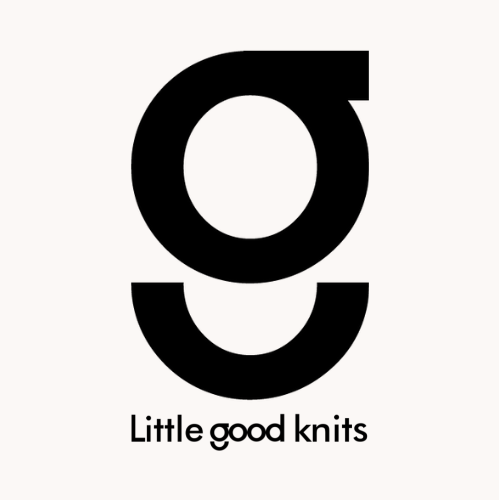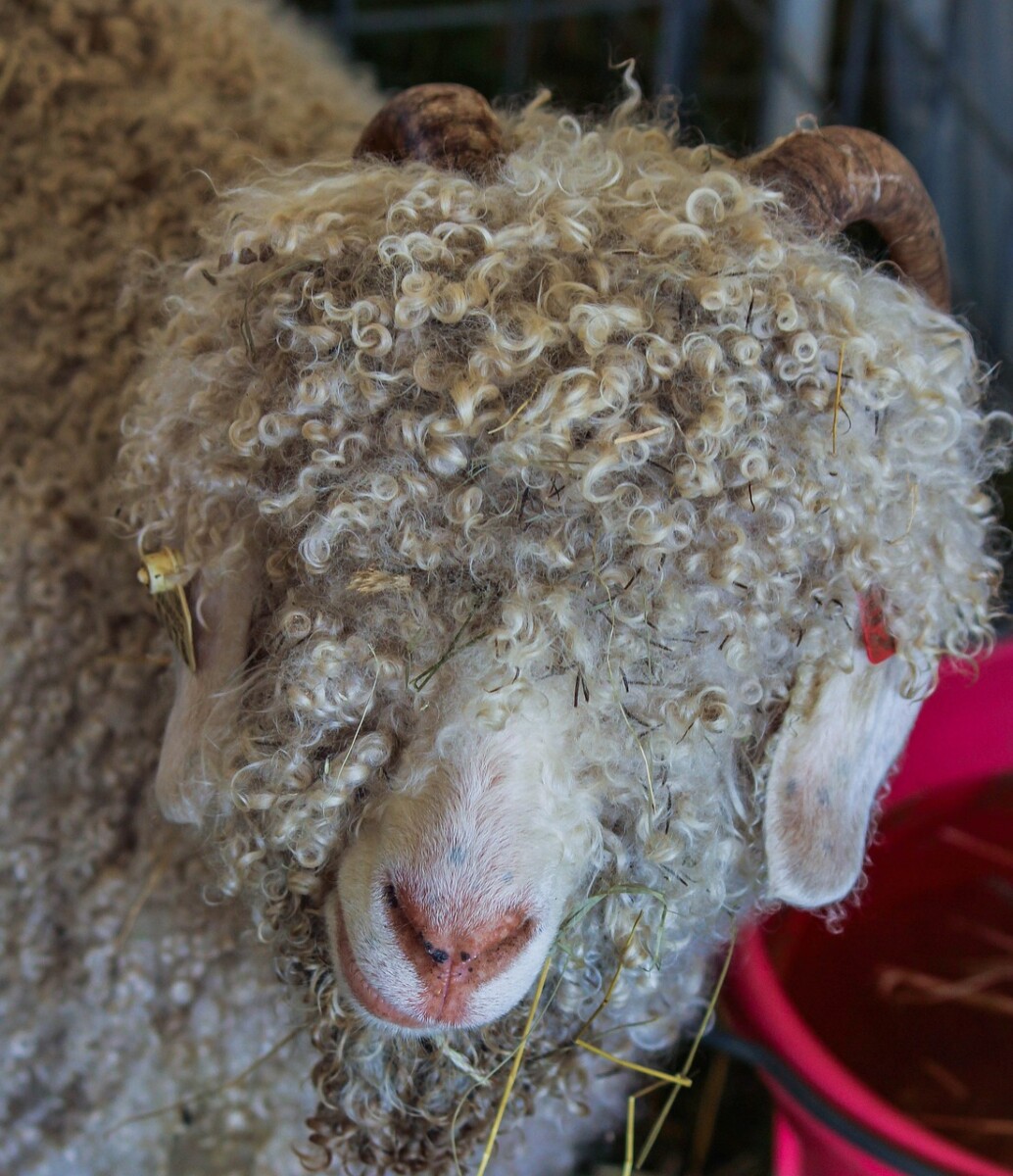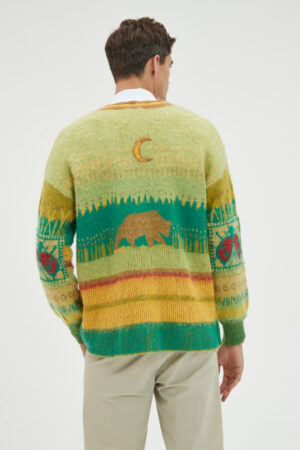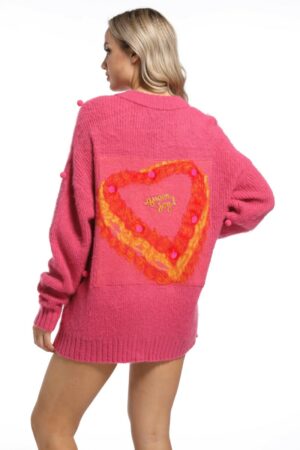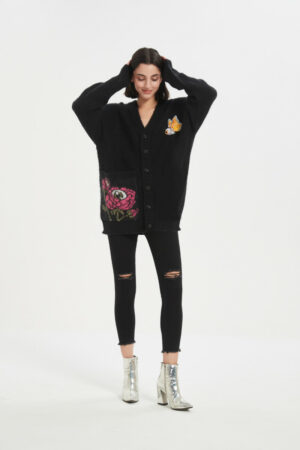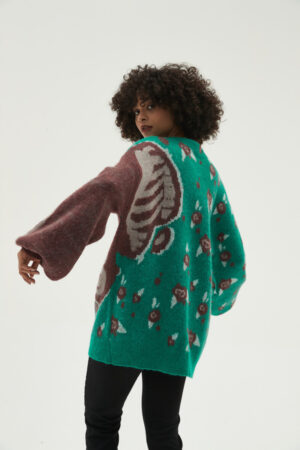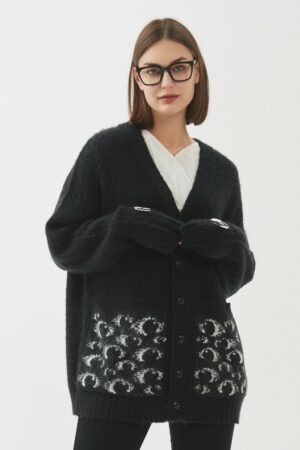Mohair means a beautiful and luxurious knitting fabric made from the hair of the angora goats; many knitters and fashion designers choose to use a mohair blend yarn because the gloss and shine of mohair accent any garment or accessory.
Mohair fabric is popular for knitting cold-weather clothing such as sweaters, cardigans, knit top, vest, socks, hats, gloves, and scarves because it has the same insulating characteristics as wool but is lighter-weight, has a nice shine, and lasts longer. It is popular for both men and women for its trending signature fluffy and fuzzy look.
Looking for a mohair sweater manufacturer or custom knitwear production partner? Check out the linked guide or contact us through this form below!
What is mohair fabric?
Mohair is a smooth, silk-like material made from the coats of Angora goats. Mohair is a highly valued natural fiber. Everything from high-end knitwear and accessories to carpets and upholstery is made with it.
The definition of mohair is that the yarn is made from the hair of the Angora goat. This should not be confused with Angora wool, which is made from the fur of the Angora rabbit.
What is mohair wool?
The angora goats are shorn twice a year, and they generate a single coat of excellent mohair wool (most wool-producing animals create two coats).
The fleece of elder goats is coarse and is often used for upholstery. It was used for upholstery before popularly utilized synthetics for things like theater and railway seats because it is a robust fabric that can withstand heavy wear. The fleece used in knitting is derived from Angora kids (young goats), and the fiber is known as kid mohair, which is the softest and finest grade of mohair. Because it only originates from young goats, mohair used for knitting is also a costly fiber.
Mohair fibers range in length from 4 to 12 inches and have fewer scales down the shaft than wool, making it smooth and shiny. This also indicates that it will not feel as easily as wool (the scales on wool fibers allow it to felt so quickly). However, since it is smooth, it must be carefully spun so that it does not come apart. It’s most often spun as a ‘brushed’ fiber with a halo or fuzziness.
Another fascinating feature of mohair is the presence of air pockets in the cortex (the center of the hair shaft). This makes the fibers highly lightweight as well as excellent insulators, thus mohair is an excellent option for clothes that keep you warm in cold weather.
What is mohair yarn?
Mohair is a premium yarn. It’s pleasant to knit or crochet with (if you don’t find it scratchy), blends well with other yarns, and can be used for a variety of crafts. Mohair yarn has many of the same qualities as wool, but it also offers certain particular properties to a yarn mix.
Mohair yarn is:
- very lightweight
- warm and insulating
- has nice drape
- hard wearing
- receptive to dye
- easy care
But mohair yarn does have a few disadvantages:
- less resilient than wool
- can feel prickly
- sheds if lightly spun
- expensive
- difficult to ‘frog’ or fix knitting mistakes
What is mohair velvet?
Mohair is a fabric weaving yarn, while velvet is a weaving procedure used to create a thick pile fabric1. Mohair velvet is a luxurious, long-lasting velvet upholstery fabric derived from Angora goats. It is naturally flame resistant and resistant to moisture wicking, stretching, and creasing. Mohair velvet is one of the most popular velvet fabric selections since it is often quite durable and has an inherent Crib 5 pass.
What is mohair upholstery fabric?
Mohair upholstery fabric is a high-end fabric manufactured from Angora goat hair. It has a high shine and gloss and may be dyed in a variety of rich and lovely hues. It is also long-lasting, tough, crease-resistant, and flame retardant. Mohair is often used in fiber mixes to impart these properties to a textile.
What does mohair blend mean?
First and first, there is no such thing as 100% pure mohair knitwear in the world; if you find someone selling it, it must be a fraud. Mohair is often blended with other materials for a variety of reasons. Because mohair is such fine hair, it is blended with other fibers to create chunky and worsted (medium weight) skeins or yarn lengths. Mohair adds gloss to fibers when combined with alpaca or merino. For increased strength, mohair yarn is sometimes combined with silk yarn, wool yarn, and merino wool. When mixed with synthetic yarns, the yarns become more affordable, durable, and retain their fluffy and fuzzy look.
What does mohair-like mean?
Simply said, there is no mohair in the knitwear. To get the signature fluffy and fuzzy appearance, cheap synthetic materials are used. Long-priced knitwear or dishonest knitwear dealers often use this approach to confuse buyers and maximize profits. If you encounter mohair sweater for less than a hundred dollars, it is most likely a “mohair-like” scam.
What is brushed mohair?
Brushed mohair is “brushed” by hand or machine to have a less-defined, fuzzy appearance. It is very lofty, with a lot of volume per weight, so you can make a blanket or sweater that keeps you warm without weighing you down. Brushed mohair needs to same amount of care as mohair blend or mohair wool knitwear, the best way is hand wash then dry flat.
Do you need an experienced mohair wholesale knitwear supplier? We are based in London, UK and we are ready for your questions.
What is mohair made from?
Mohair is a silky wool made from the Angora goat’s hair. Mohair yarn is often referred to as the “diamond fiber,” since the wool has a particular gloss and sheen. Mohair adds shine to other fabrics, such as alpaca or merino, when combined with them.
The diameter of the fiber grows with the age of the goat, and younger goats’ fibers are used more for apparel, such as sweaters, while older goats’ fibers are used for carpets, upholstery, curtain fabric, and outerwear. Because the manufacturing method for mohair is more complicated than that of regular sheep’s wool, it is regarded a premium fiber, akin to cashmere or Angora.
Where is the origin of mohair?
Mohair, one of the world’s oldest fiber fabrics, developed in the highlands of Tibet, where the Angora goat formerly thrived. The Angora goat was imported to Turkey in the sixteenth century, and the term “angora” derives from the Turkish region of Ankara. Angora goats were almost exclusively raised in Ankara until 1849, when they were presented as a gift to a United States cotton farmer in appreciation for his assistance in helping Turkey plant cotton.
Today, the mohair is obtained from mainly South Africa, which is the biggest angora goat breeder, farm and exporter of mohair, as well as Argentina, Turkey, and the United States state of Texas. Australia and New Zealand, to a lesser degree, also manufacture and export mohair.
How is mohair harvested and obtained?
Mohair farms shear their sheep twice a year, in the spring and in the autumn. The mohair manufacturing process then entails washing the wool to remove any dirt, debris, and oil. Mohair manufacturers then spin the wool into yarn to knit or weave mohair fabric.
Are goats killed for mohair?
No, goats are not killed for their mohair. According to our mohair suppliers, “You do not have to kill a goat to harvest its mohair, so they usually are not killed for it. They are not hunted for it, either, as mohair is only found on the Angora goat, which are entirely domestic and not wild.”
Is mohair ethical?
Harvesting mohair do not harm the angora goat’s longevity or overall well-being, whether mohair is ethical depends on the goat farm situation and whether the goat owners care about the angora goats outside their mohair.
What is mohair used for?
Mohair offers a wide range of uses, including knitwear, home decor and furnishing, fake fur for teddy bears, upholstery fabric, carpets, drapery, sofa, rugs, and even doll wigs.
What are the benefits of mohair?
Mohair is a desirable fabric because it gives any object strength, warmth, and elegance.
- Shiny – Mohair is exceptionally glossy and silky, having properties akin to silk.
- Strong and tenacious – Mohair, like many natural wool fibers, is very robust and durable. Mohair is stronger than steel of comparable dimensions.
- It does not felt – Mohair lacks scales, which are cuticle cells that join to make felt. Mohair lacks this structure and so cannot be felted.
- It dyes well – Mohair fabric takes dye incredibly well, making it an excellent choice for adding color to a garment or household item.
- Warm – Mohair is an excellent insulator and is quite warm while keeping light weight.
- Silk-like – Mohair has a natural sheen that sparkles when exposed to light. The mohair fiber itself is as silky as silk, making any mohair seem opulent.
- Excellent for sensitive skin – Mohair is suitable for persons with sensitive skin since the wool is less scratchy than regular sheep’s wool.
- It does not wrinkle – Because to the fiber structure, mohair resists creasing.
- Moisture-wicking – Mohair, like most wool, wicks moisture and is inherently flame retardant.
What are the disadvantages of mohair?
Mohair does have some great qualities, but there are also some disadvantages of mohair. These include:
- Expensive – The price of mohair is one reason many people look elsewhere for their fiber needs. It’s possible to find some blends that are less expensive, but if you’re only looking at pure mohair yarns then the cost can be prohibitive.
- Less Resilient Than Wool – Mohair is not as resilient as wool, which means that it may not hold up as well over time.
- Can Feel Itchy – Some people find that mohair can feel prickly against their skin, but there are ways to stop the knitwear from itching.
- Sheds If Lightly Spun – Mohair has a tendency to shed if it is lightly spun.
Is mohair expensive?
Mohair is considered a luxury fabric and is often more expensive than other types of knit fabrics. The price of mohair varies depending on the quality and the supplier. It is generally more expensive than other types of wool.
How much is mohair worth?
The price of mohair varies depending on the quality and the supplier. You can expect to pay anywhere from $10 to $350 per pound for mohair yarn.
Is mohair warm?
Yes, mohair is warm. Mohair is warm because it is an excellent insulator. It is also valued for certain other unique characteristics: it is warmer than other fibers, even when used to make a light-weight garment. Mohair owes its renowned warm weather reputation to low heat conductivity, which allows it to wear cool, and its ability to absorb a third of its weight in moisture without losing shape or feeling wet to the touch.
Is mohair soft?
Yes, mohair is soft. Mohair is a very soft yarn when compared with other natural and synthetic fibers. The mohair fiber itself is soft like silk, making any mohair feel very luxurious.
Mohair is soft because the fibers have fewer scales on the external layer than sheep wool. This makes mohair extremely soft, which makes it perfect for people with sensitive skin or who find sheep wool a bit itchy. The younger animals tend to produce softer and shinier fibers, while the wool from older angora goats is not considered as desirable as that of their younger counterparts.
Mohair yarn substitute
If you’re looking for a substitute for mohair yarn, there are several options available. Some alternatives include:
- Brushed Suri – It has a similarly light and fluffy fiber, and a similar softness, but it doesn’t irritate a lot of people who find mohair irritating.
- Silk, bamboo, and other viscose fibers – They lend themselves to designs with a heavy, swinging drape.
- Cashmere – It gives a light, airy drape but gives a completely different touch and look.
Mohair vs cashmere
Mohair and cashmere are both luxurious fabrics that possess similar qualities. Mohair comes from the Angora goat, whereas cashmere is obtained from the Kashmir goat. Cashmere is often considered to be softer and finer than mohair and has a unique texture that allows it to drape beautifully, making it ideal for clothing and accessories. In contrast, mohair has a more textured appearance that can add depth and interest to fabrics. Cashmere is considered the more luxurious of the two due to its finer and softer texture, as well as its higher price tag.
Mohair vs angora
The primary distinction between mohair and Angora wool is that Angora wool is derived from Angora rabbits, whilst mohair wool is derived from Angora goats. Both are very tough and robust, with a smooth and soft texture.
Ready to own your first mohair knitwear? Little Good Knits partner with subculture creators to design artsy knitted jumpers and scarves. You can shop our collaboration designs HERE. For any other questions, feel free to get in touch!
